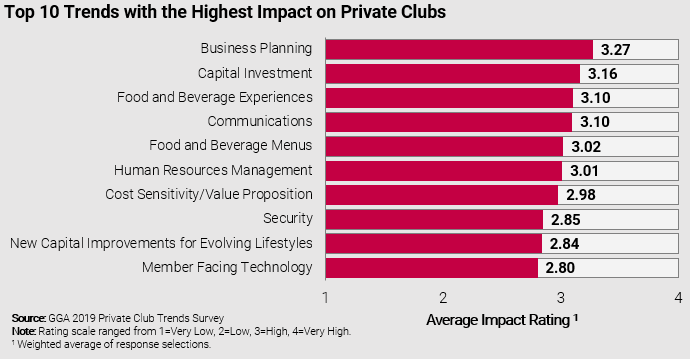New GGA Partners Research Report Highlights Private Club Members’ Perspective on COVID-19 Impact
More than 6,300 private club members share their attitudes toward the club industry in the wake of the COVID-19 pandemic and how they expect clubs to respond. Now available for download.
TORONTO, Ontario – GGA Partners – international consulting firm and trusted advisor to many of the world’s most successful golf courses, private clubs, resorts, and residential communities – has released the results of a global research survey of more than 6,300 private club members across six countries on four continents.
The research, which incorporates clubs in the United States, Canada, Europe, Australia and China, measures the attitudes and preferences of private club members on club operations and finance in the wake of the COVID-19 global health crisis.
“The coronavirus pandemic has shifted the private club landscape in many ways and these research findings offer insight into the near-future ripple effects with which club leaders must reckon,” explained Derek Johnston, a Partner in the firm. “As an industry advisor for trends shaping private club strategy, our team at GGA Partners is doing all that we can to help club leaders navigate the crisis and strengthen their understanding of how to react and adapt in order to meet the morphing needs and expectations of members.”
Overall results are encouraging; members feel highly positive about the crisis-management performance of their clubs and indicate that the importance of “the Club” in their lives has not been negatively impacted by the pandemic, but rather reinforced.
“In terms of correlation, the more effectively clubs have performed during the COVID-19 pandemic, the more important they became in the lives of members,” stated Ben Hopkinson, Director Client Success and Sales at GGA Partners. “Together, these results suggest that, for members, the importance and relevance of their club experience is strengthened during emotionally challenging times.”
However, despite the enduring importance of the club in their lives, members’ high-level economic outlook over the next 12 months is more somber: 43% expect their disposable income to decrease and 58% believe their overall consumer spending will as well. Perhaps most disheartening is members’ outlook on how their club’s financial position will change: 71% envisage a decline, with 20% characterizing the anticipated decline as ‘significant’.
In response to anticipated downward financial pressures, members expect their clubs to adapt operationally by scaling back certain high-touch areas of operations to simultaneously reduce club operating costs and the risk of COVID-19 transmission. The extent of operational changes is predicted to be moderate in nature – only 12% of participants envision changes characterized as ‘significant’ or ‘drastic’.
The majority of private club members indicate their understanding of the need for operational adaptions to reduce costs, showing stronger support for changes which reduce service offerings and availability than those which increase their cost to belong.
The good news for club operators is the implication that operational scale-backs, service reductions, and restricted/limited access to amenities and activities – essential maneuvers to safely and responsibly navigate a virus-ridden social environment – are unlikely to cause significant membership attrition. The tough news is that increasing dues beyond the norm – or allowing the value and quality of club amenities to diminish – just might push members away in the short-term.
According to Patrick DeLozier, Director at GGA Partners, constant evolutions in the COVID-19 pandemic place enhanced pressure on the planning capabilities of club leaders. “It’s really a day-to-day for managers,” he said. “The stop-and-start reality of new case development and safety protocols requires club managers to have up-to-date information and the support of very sound research and data to work through challenges with the club’s board of directors.”
This means that club leaders need to have a plan for what they’re going to do next as the situation evolves quickly and unexpectedly. “The need for data-driven analysis, diligent financial monitoring, and a prepared communications strategy is more prevalent than ever,” DeLozier clarified. “To sustain forward-thinking, club leaders need to have a ‘Plan C’ for the ‘Plan A’. Pandemic-related changes are so rapid that, if you can’t adapt quickly, you’re well behind the eight ball.”
These results and more are detailed in a report titled A Member’s Perspective: The Shifting Private Club Landscape, now available for download.
Click here to download the report and see the findings
About GGA Partners
GGA Partners™ is an international consulting firm and trusted advisor to many of the world’s most successful golf courses, private clubs, resorts, and residential communities. We are dedicated to helping owners, asset managers, club and community leaders, investors and real estate developers tackle challenges, achieve objectives, and maximize asset performance.
Established in 1992 as the KPMG Golf Industry Practice, our global team of experienced professionals leverage in-depth business intelligence and proprietary global data to deliver impactful strategic solutions and lasting success.
For more information, please visit ggapartners.com.
Contact
Bennett DeLozier
GGA Partners
602-614-2100
bennett.delozier@ggapartners.com














